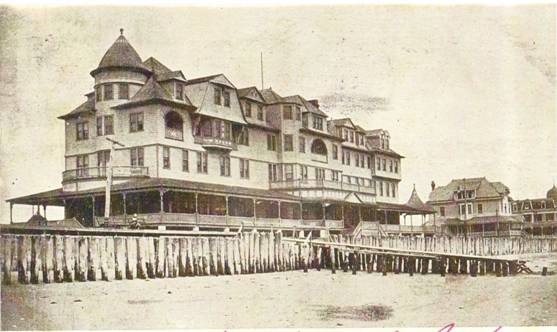Sea Isle had become an official “Borough” on May 16, 1882. By 1885 it had become a growing resort with hotels and rooming houses, a wide and welcoming beach, a popular activity center (Excursion House), a post office, its first school (in the Aldine Hotel), churches, and numerous fledgling businesses and stores. It also had a railroad and a usable turnpike to bring visitors and potential buyers to town. Charles Landis, the town’s founder, had begun to see his dream come true. But this was just the beginning.
Over the next several years there was evidence of growth everywhere:
- Construction prospered. By the turn of the 19th century there were about 300 buildings in Sea Isle. Hotels, rooming houses, and private residences continued to be built. The grandest hotel was the Continental (1889) located at 25th Street at the beach. It was one of the largest hotels along the coast outside of Atlantic City.
- Rail travel to Sea Isle became so popular that a second railroad, the Atlantic City RR, joined in competition with the existing West Jersey line in 1893 to bring people to the shore. By this time, there were three railroad bridges to Sea Isle along the coast: the Townsend’s Inlet Bridge plus two bridges to the north over Corson’s Inlet. A Sunday excursion along the shore cost a dollar.

- In 1887, trolley service was initiated between Sea Isle City and Townsend’s Inlet along Landis Avenue with the terminus at the site of the current Townsends Inlet Civic Center. It was later extended north. This first “trolley” was actually a horse car pulled by mules. Unfortunately, no photos seem to exist.
- Two Sea Isle churches had been established earlier in the 1880s, Methodist and Catholic. Both were later moved to their current locations. At the end of the 19th century, the Methodist church was on 40th Street near the train station, and the Catholic Church was at 44th and Central Ave. The city’s first public school building was erected in 1893 on 44th Street.

- Fishing as an industry began in Sea Isle around 1890 primarily with pound fishing, where huge nets were staked in the ocean to capture the fish into a “pound.” The Pfeiffer brothers, Walter and Clarence, owned two of the earliest fisheries. A decade later, many families came from Italy to join in this growing industry. Many of those families remain here to this day.
- In 1885, Ludlam’s Beach lighthouse was erected. Three new life-saving stations were constructed on the island in the 1890s at Corson’s Inlet, at 32nd Street, and at Townsend’s Inlet, this last one to replace the first station built in 1850.
All this, and more, was accomplished in Sea Isle during the last part of the 19th century. Charles Landis died at his home in Vineland on June 12, 1900, at the age of 67, but he lived long enough to see that his dream for the town was being realized. Seven years later, Sea Isle was finally to become officially recognized as a “City.”

To learn more about this intriguing era and browse through hundreds of related photographs, please visit the Sea Isle City Historical Museum at 48th Street and Central Avenue (on the first floor of the Library). You can access the museum’s website at www.seaislemuseum.com or call 609-263-2992 with any questions. The Museum’s current summer hours are 10:00 a.m. to 3:00 p.m., Monday, Tuesday, Thursday, Friday and Saturday, plus 6:00 p.m. to 8:00 p.m. on Monday evening.








